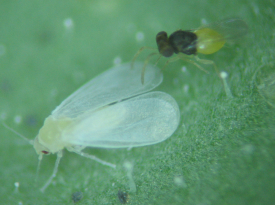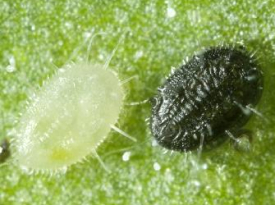- Track your orders
- Save your details for express checkout



Shopping
Tamarixia for Psyllid Control
Tamarixia triozae - Parasitic Wasp
Tamarixia is a small parasitic wasp that specialises in parasitising tomato potato psyllid (Bactericera cockerelli).
Tamarixia is known to be useful in indoor and outdoor crops such as, capsicum, tomato, potato and eggplant as part of an integrated pest management programme.
Tamarixia triozae is a black parasitic wasp. Females prefer to lay eggs on 4th and 5th instar psyllid nymphs and adults are also predators and feed on 1st and 2nd instar nymphs.
A female Tamarixia lays a single egg on the underside of the psyllid nymph, between the nymph and the leaf, gluing the egg to the underside of the nymph. A single female can lay up to 165 eggs during her lifetime.
The parasitoid larva will feed on the TPP nymph and kill it. It becomes an adult within the remains of the TPP nymph then it chews a hole through the TPP nymph shell to emerge as an adult. You can tell if a TPP nymph has been parasitized by the distinctive round exit hole.

The pest: whitefly (left) & the solution: Encarsia (right)

Normal whitefly pupa (white) and parasitized pupa (black). An adult Encarsia will emerge from the black scale(right)
The Pest: Tomato Potato Psyllid
The tomato potato psyllid (TPP) was first found in New Zealand in 2006 and has spread throughout the country. It may transmit a bacterium, Candidatus Liberibacter solanacearum that causes a disease in its host plants. TPP breeds all year, especially in the warmer parts of the country and in greenhouses. It develops between 15C and 32C with optimum development at 27C.
Adult tomato potato psyllids are small insects, similar in size to aphids. They have wings and look like small cicadas with a distinctive white band on the abdomen. The two pairs of transparent wings are held over their abdomen. A female can lay up to 500 eggs over a 21-day period, but in the field it is more likely to be around 200 eggs.
TPP eggs are yellow and attached to leaves by a thin short stalk. The eggs may be laid on all parts of the leaf and plant stem, but are often found on the leaf edge where they are most easily seen.
Nymphs hatch from the eggs. They are flat and scale like, and have three pairs of legs and sucking mouthparts.
There are five nymphal stages, each is called an instar. Nymphs settle on young leaves, mainly on the underside. Although they can walk, they spend much of their time motionless with their stylets inserted into the plant feeding on the plant sap and they excrete the excess water and sugar, which is called honeydew.
Symptoms and signs of psyllids include:
-
Stunting and distortion of the leaves and flowers
-
Yellowing and wilting of leaves
-
Honey dew and sooty mould present on the plants
Life Cycle
Parasitised TPP nymphs died 4 days after the Tamarixia egg was laid but it could take up to 12 days to see the exit holes.
Under environmental conditions of 26°C:
-
Development time (egg to adult): 12 days
-
Adult female life span (honey-fed only): 47 days
-
Number TPP eaten per day: 3
-
Number TPP parasitized per day: 3 to 7
Environmental Conditions
Tamarixia is best suited to temperatures between 18°C and 30°C, and sustained temperatures over 30°C may reduce the effectiveness of this parasite.
PackagingTamarixia
Tamarixia is dispatched as live adult wasps in a vial, and sent via courier.
Application Rates
-
0.5 Tamarixia adults per m2 as a PREVENTATIVE measure, preferably fortnightly before psyllids are found in the crop
-
1 Tamarixia adult per m2 as a light to moderate CURATIVE measure, over several weeks as psyllids are found in the crop
-
easure, over several weeks as psyllids are found in the crop
- Heavier infestations of psyllids can benefit from the simultaneous release of Mite A, or may require initial chemical intervention (contact Bioforce to discuss).
Because psyllids breed very quickly, it is recommended that Tamarixia is released at the first sign of psyllid appearance.
Release and Storage Instructions
Tamarixia needs the following handling and treatment:
-
eaves in the morning or the evening
-
Do not expose Tamarixia to direct sunlight
-
DO NOT REFRIGERATE
-
Store in a call place if need be, in the dark, for up to 2 days after reception.
-
Open the vial only once you are in the area in which Tamarixia are to be released
Post Release
Tamarixia will start parasitising psyllid nymphs immediately on release, although you will not be able to confirm this until the parasitised psyllid starts turning golden after 7 days (at 26C) or longer if the average temperature is lower.
Before introducing Tamarixia into your crop please check residual chemical affects and ensure you know chemical compatibilities of products that may be applied.